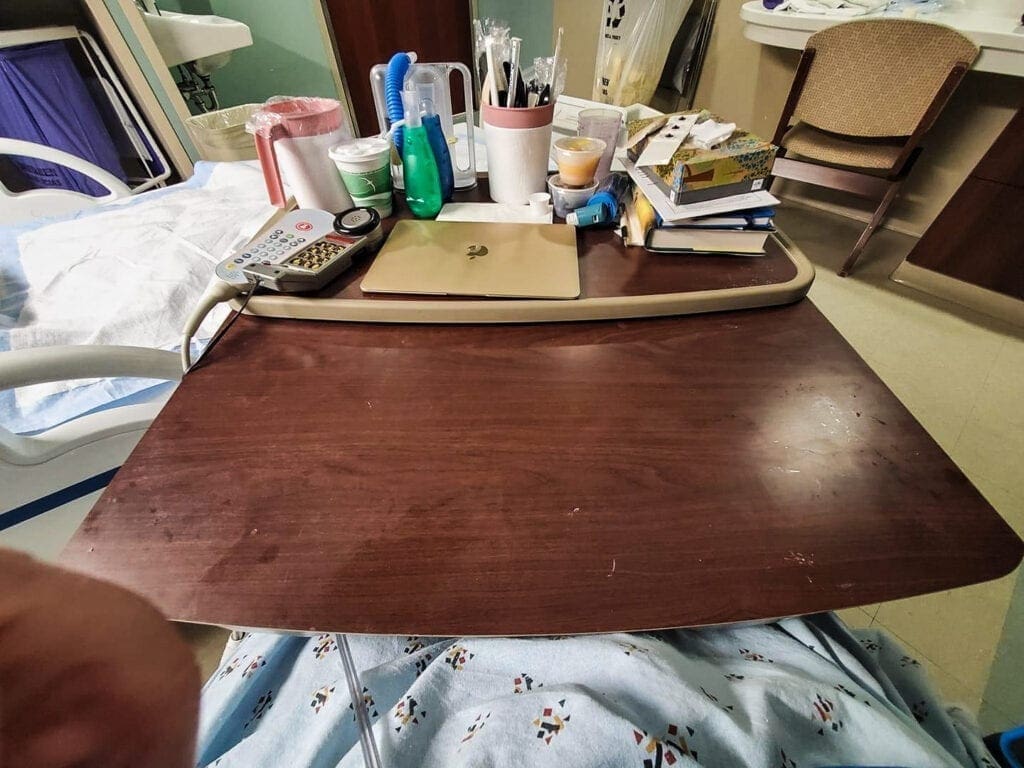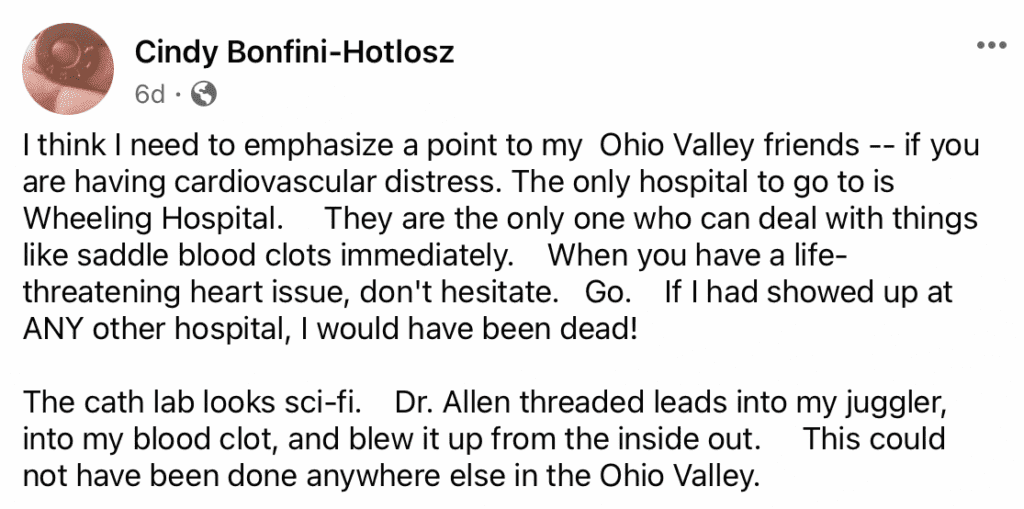(Publisher’s Note: With today’s announcement about a new, “highly transmittable” variant named “Omicron,” we believed this archived article about a local lady who struggled horribly with Covid-19 would be appropriate for this evening. Thank you again, Cindy, for sharing the realities of your battle.)
One-two-three-four-five.
But it was only a family birthday party, and it had far fewer than the state’s restrictions. Some in attendance said they were tired, but who isn’t exhausted with trying to live under all of the “new normal” practices? But one family member came with Covid on her breath, and one by one, the four others tested positive within seven days.
That included Cindy Bonfini-Hotlosz, an adjunct professor for Georgetown University, chief executive director of Centreity, and resident of West Liberty. She also owns and operates the Empress Emporium at 700 Main St., and Bonfini-Hotlosz has promised customers she will reopen the shop in 2021.
That is, now that she knows she can.
“My family made a birthday cake for his sister. As we had been very careful, we felt safe going to his house. We knew the risk, but we felt it was minimal,” she recalled. “We picked up pizza, a salad, and we had the cake. I arrived late. We were there about an hour. There were five of us.
“The next day, one of us tested positive. Two days later, another one. By seven days, all five of us were positive with COVID-19,” Bonfini-Hotlosz said. “My symptoms started off mild. I had sniffles, was congested, and had a slight sore throat. Four days later, I had pneumonia in both lungs. My first hospital visit was Trinity in Steubenville. We had heard Wheeling was filled. I was admitted and put on oxygen, steroids, and antibiotic.”

But then she heard of one more treatment that could, maybe, knock down the virus and allow her to feel much better without the complication she feared most.
“There was an infusion available, but to take it, I had to get discharged from the hospital since it was experimental,” Bonfini-Hotlosz explained. “There was a major confusion on whether or not I got the right tests, and I had to retest. It was chaos. I finally received the infusion at the ER in Steubenville.”
But then.
“That afternoon, I took a shower, and I don’t remember anything else except the Tri-care Ambulance arriving. I wasn’t breathing,” she remembered. “There was no hesitation going to Wheeling Hospital. I was dying.”

Cause and Effect
Since the beginning of the global pandemic, the people of the world have been warned that COVID-19 harshly attacks the elderly and those with autoimmune disorders and pre-existing conditions. The coronavirus attacks an individual’s respiratory system, and Bonfini-Hotlosz’s primary condition once hospitalized was a saddle pulmonary embolism, or “saddle clot.”
Such a clot could prove fatal if untreated, and she didn’t even know it was lingering in her jugular vein.
“I just saw a phenomenon later I will consider ‘angels’. They were all around me. The first time I saw the doctor, they were all around him. He held up one finger, like ‘wait’ and I gave him a smile and thumbs up,” she said. “Dr. Christopher Allen saved my life. He had joined the WVU Wheeling team on October 2. Had I not had that doctor at that moment, I would be one of the numbers. I had a cardiovascular event. Dr. Allen used a technology called EKOS to insert leads into one of my jugular veins. I was awake for the procedure. I heard in their voices the relief when it was over.
“I spent the next six hours lying flat in ICU while Heparin dripped on the clot. It felt like six months. My nurse, Garret Meggs and the aide, Noah Matthews, kept me going,” Bonfini-Hotlosz said. “They asked things like ‘what would you like to eat when this is over and just the idea from near-death to eating cottage cheese and peaches made me think I was going to be fine. They checked on me, told me the time, kept me going, and when the six hours were up, then Noah and Garret pulled the leads out of my heart.”

An Online Account
She coined it her “Rona Journey.”
Bonfini-Hotlosz, once awake and able, began a series of Facebook updates in her personal timeline about her experience through an illness she feels far too many discounts because of global statistics concerning survival rates. After all, in Ohio County, more than 2,600 residents have tested positive as of yesterday and 40 have passed away after being diagnosed.
The point made with her posting, however, was that suffering and recovering from COVID-19 cannot be sheltered by numbers and expectations but instead by a personal reality.

“I have heard so many people say to me, ‘It’s 99 percent survivable,’ and I have heard people assign political views to this virus. I watch people be careless with masks, wearing them below their chin and exposing their nose,” Bonfini-Hotlosz insisted. “If they knew that carelessness could kill someone they love, would it make a difference?
“I felt compelled to tell my journey, and if I could save the life of one other person, it would be worth it,” she continued. “My friends are mostly near my age. Just that puts them at risk. If you have any other co-morbidities, you are at risk. We are the grandparents who watch the kids. We are the shop owners with small businesses. We have kids in college that want to come home to see us. And we need to be careful.”

Day Was Night. Night Was Day.
The hour of the day didn’t matter even though a clock in the room told the time.
Instead, it was about waking up from time to time to see life again. Visitors made their way into Bonfini-Hotlosz’s hospital only virtually, and her dreams were clear during the latter stages of recovery. She was diagnosed near Thanksgiving after that birthday party, and she didn’t go home until four days before Christmas.
“I was dying. People rarely survive the type of clot I had. My friend who is a nurse called me, and we cried together,” she said. “She said when she found out, she didn’t think I would make it. She had already lost a cousin who was my age to this.
“Now, the prognosis is good for me. Once I got past the initial phase and survived, I am now on blood thinners, so no new clots will form. I will be on blood thinners for three to six months. I will be on oxygen another month,” Bonfini-Hotlosz explained. “I had the right hospital with the right equipment with an expert doctor who kept me alive. My journey started November 23 at a birthday party. I was released from the hospital December 21. We don’t really know when it will end since no one knows the long-term effect of COVID-19.”

There were moments she would recall everyone in her life; how much they meant to her and how painful it was not to see them. Bonfini-Hotlosz felt her body slipping away for reasons she didn’t now about when walking into Wheeling Hospital.
During her most recent check-up, the physician was frank when telling her she very well could have become a number tossed on top of Covid-19’s death toll that’s reached more than 345,000 in the U.S. and 82 million worldwide.
“It was a Christmas miracle to my family and friends. I was amazed at the number of people who have told me they read my journey and that they made different choices to stay safe or convince others to stay safe,” Bonfini-Hotlosz added. “We are so close to a solution. If people can respect each other enough to socially distance, wear masks in public and avoid small gatherings, you will not be worrying whether your loved ones are at risk.”


